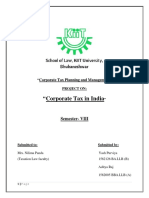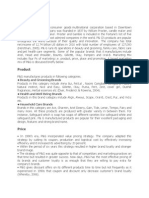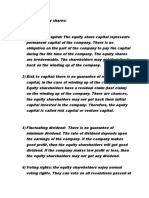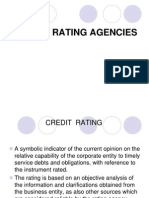Commercial Paper
Commercial Paper
Uploaded by
Krishna Chandran PallippuramCopyright:
Available Formats
Commercial Paper
Commercial Paper
Uploaded by
Krishna Chandran PallippuramOriginal Description:
Original Title
Copyright
Available Formats
Share this document
Did you find this document useful?
Is this content inappropriate?
Copyright:
Available Formats
Commercial Paper
Commercial Paper
Uploaded by
Krishna Chandran PallippuramCopyright:
Available Formats
Commercial Paper (CP) is an unsecured money market instrument
issued in the form of a promissory note. As part of efforts to develop the money market, Commercial Paper (CP) was introduced in India in 1990 with a view to enabling highly rated corporate borrowers to diversify their sources of short-term borrowings and also provide an additional financial instrument to investors.
Maturities
on commercial paper rarely range any longer than 270 days. The debt is usually issued at a discount, reflecting prevailing market interest rates. CP may be issued to and held by individuals, banking companies, other corporate bodies registered or incorporated in India and unincorporated bodies, Non Resident Indians (NRIs) and Foreign Institutional Investors (FIIs). However, investment by FIIs would be within the limits set for their investments by Securities and Exchange Board of India (SEBI).
CP
can be issued either in the form of a promissory note or in a dematerialised form through any of the depositories approved by and registered with SEBI. CP will be issued at a discount to face value as may be determined by the issuer.
The present guidelines for issue of Commercial Paper (CP) by Companies, Primary Dealers and Satellite Dealers are governed by the Directions issued by Reserve Bank of India (RBI). The Reserve Bank in exercise of the powers conferred by Sections 45 J, 45 K and 45 L of the Reserve Bank of India Act, 1934 issues the following guidelines replacing all earlier directions/guidelines on the subject
(a)
the tangible net worth of the company, as per the latest audited balance sheet, is not less than Rs. 4 crore; (b) company has been sanctioned working capital limit by bank/s or all-India financial institution/s; and (c) the borrowal account of the company is classified as a Standard Asset by the financing bank/s/ institution/s.
CP
can be issued for maturities between a minimum of 15 days and a maximum upto one year from the date of issue. CP can be issued in denominations of Rs.5 lakh or multiples thereof. Amount invested by single investor should not be less than Rs.5 lakh (face value). The total amount of CP proposed to be issued should be raised within a period of two weeks from the date on which the issuer opens the issue for subscription.
CP
may be issued on a single date or in parts on different dates provided that in the latter case, each CP shall have the same maturity date. Every CP issue should be reported to the Chief General Manager, Industrial and Export Credit Department (IECD), Reserve Bank of India, Central Office, Mumbai through the Issuing and Paying Agent (IPA) within three days from the date of completion of the issue.
major benefit of commercial paper is that it does not need to be registered with the Securities and Exchange Commission (SEC) as long as it matures before nine months (270 days), making it a very cost-effective means of financing. The proceeds from this type of financing can only be used on current assets (inventories) and are not allowed to be used on fixed assets, such as a new plant, without SEC involvement.
In
comparison to bank borrowing, commercial paper can generally be issued at below the prime rate. Furthermore, there are no compensating balance requirements, though the firm is required to maintain approved credit lines at a bank. Finally, there is a certain degree of prestige associated with the issuance of commercial paper.
Commercial
paper is a short-term unsecured promissory note issued by corporations and foreign governments for many large, creditworthy issuers. Commercial paper is a low-cost alternative to bank loans. Issuers are able to efficiently raise large amounts of funds quickly and without expensive Securities and Exchange Commission (SEC) registration by selling paper, either directly or through independent dealers, to a large and varied pool of institutional buyers.
Commercial
papers has become one of America's most important debt markets, because of the advantages of commercial paper for both investors and issuers. Commercial paper Involves Less Documentation Diversification of Sources of Finance High Rate Of Return Unsecured Instrument High Liquidity
Corporates,
primary dealers (PDs) and satellite dealers (SDs), and the all-India financial institutions (FIs) that have been permitted to raise short-term resources under the umbrella limit fixed by Reserve Bank of India are eligible to issue CP.
All
eligible participants shall obtain the credit rating for issuance of Commercial Paper either from Credit Rating Information Services of India Ltd. (CRISIL) or the Investment Information and Credit Rating Agency of India Ltd. (ICRA) or the Credit Analysis and Research Ltd. (CARE) or the FITCH Ratings India Pvt. Ltd. or such other credit rating agency (CRA) as may be specified by the Reserve Bank of India from time to time, for the purpose.
You might also like
- Branch AccountingDocument38 pagesBranch AccountingUmra khatoonNo ratings yet
- Internship Report FormatDocument4 pagesInternship Report FormatMian AhsanNo ratings yet
- AtmDocument19 pagesAtmKrishna Chandran PallippuramNo ratings yet
- Webinar 2019 Mining Financial Model ValuationDocument30 pagesWebinar 2019 Mining Financial Model ValuationThanh NguyenNo ratings yet
- Cheat Sheet For Financial AccountingDocument1 pageCheat Sheet For Financial Accountingmikewu101No ratings yet
- Tax Planning With Reference To New Business - NatureDocument26 pagesTax Planning With Reference To New Business - NatureasifanisNo ratings yet
- Segment ReportingDocument4 pagesSegment ReportingAlex FungNo ratings yet
- Final Tax Planning ProjectDocument14 pagesFinal Tax Planning ProjectyashNo ratings yet
- TCS - in Income TaxDocument8 pagesTCS - in Income TaxrpsinghsikarwarNo ratings yet
- Hero Moto CorpDocument4 pagesHero Moto Corpsouravag4uNo ratings yet
- On Fdi and FiiDocument18 pagesOn Fdi and FiisrisaiuniversityNo ratings yet
- Viva Questions 2Document7 pagesViva Questions 2Proshanto Chandra DasNo ratings yet
- Capital BudgetingDocument8 pagesCapital BudgetingArun AntonyNo ratings yet
- The Meaning of Audit and Assurance: By. Ayesha MunirDocument23 pagesThe Meaning of Audit and Assurance: By. Ayesha MunirAhsanNo ratings yet
- Rakesh Insplore CertificateDocument1 pageRakesh Insplore CertificateEnglish sub animeNo ratings yet
- Accounting Standards Board in IndiaDocument11 pagesAccounting Standards Board in IndiaArun PrakashNo ratings yet
- Guidelines For Mutual FundsDocument13 pagesGuidelines For Mutual Fundsajeya1987No ratings yet
- Irctc Ipo PPT FM PDFDocument12 pagesIrctc Ipo PPT FM PDFAnshita JainNo ratings yet
- Tax Planning With Respect To Amalgamation and MergersDocument29 pagesTax Planning With Respect To Amalgamation and MergerssadathnooriNo ratings yet
- ACC803 Advanced Financial Reporting: Week 2: Financial Statement Preparation and PresentationDocument21 pagesACC803 Advanced Financial Reporting: Week 2: Financial Statement Preparation and PresentationRavinesh PrasadNo ratings yet
- Capital Budgeting Management Accounting Sem V T.y.bafDocument6 pagesCapital Budgeting Management Accounting Sem V T.y.bafShravan BaneNo ratings yet
- Current Cost Accounting MethodDocument11 pagesCurrent Cost Accounting MethodJishnu Cheeroli100% (1)
- Corporate TaxDocument17 pagesCorporate TaxVishnupriya RameshNo ratings yet
- Working Capital Practical QuestionsDocument8 pagesWorking Capital Practical Questionsfatimabiriq799No ratings yet
- Kingfisher AirlinesDocument38 pagesKingfisher AirlinesMohit ShuklaNo ratings yet
- Consolidated Balance Sheet: As at 31 March, 2016 As at 31 March, 2015 Equity and LiabilitiesDocument3 pagesConsolidated Balance Sheet: As at 31 March, 2016 As at 31 March, 2015 Equity and LiabilitiesShubhendu Tiwari100% (1)
- Numericals On Cost of Capital and Capital StructureDocument2 pagesNumericals On Cost of Capital and Capital StructurePatrick AnthonyNo ratings yet
- AnalysisDocument8 pagesAnalysisradhika1991No ratings yet
- Chapter 16 - Accounts From Incomplete Records-Single Entry SystemDocument27 pagesChapter 16 - Accounts From Incomplete Records-Single Entry SystemTru eduzoneNo ratings yet
- Discount Market IntroductionDocument2 pagesDiscount Market IntroductionsadathnooriNo ratings yet
- Profits and Gains From Business and ProfessionDocument4 pagesProfits and Gains From Business and ProfessionAyaan AhmedNo ratings yet
- SA 200 (AAS 1), "Basic Principles Governing An Audit"Document6 pagesSA 200 (AAS 1), "Basic Principles Governing An Audit"dkishore28No ratings yet
- Steps in A Pre and Post Public IssueDocument8 pagesSteps in A Pre and Post Public Issuearmailgm100% (1)
- FMCG Comparative PerformanceDocument50 pagesFMCG Comparative Performanceavinash singhNo ratings yet
- Final Account of Sole Trading ConcernDocument7 pagesFinal Account of Sole Trading ConcernAMIN BUHARI ABDUL KHADER50% (2)
- Case Study Responsibility AccountingDocument6 pagesCase Study Responsibility Accountingmonika thakur100% (1)
- 15.assumption of Cost of CapitalDocument6 pages15.assumption of Cost of CapitalPownraj N100% (1)
- Marketing Mix 4ps PNGDocument2 pagesMarketing Mix 4ps PNGHCK909050% (2)
- 5.calculation of EPSDocument6 pages5.calculation of EPSVinitga100% (1)
- Unit 2: Sale of Goods On Approval or Return Basis: Learning OutcomesDocument17 pagesUnit 2: Sale of Goods On Approval or Return Basis: Learning OutcomessajedulNo ratings yet
- Marginal Costing FormulasDocument3 pagesMarginal Costing FormulasHarsimrat SinghNo ratings yet
- Mudule 5 Lecture 2Document28 pagesMudule 5 Lecture 2mmNo ratings yet
- Capital Structure and Leverages-ProblemsDocument7 pagesCapital Structure and Leverages-ProblemsUday GowdaNo ratings yet
- Ril Case StudyDocument2 pagesRil Case StudyHema Sharist100% (1)
- Tax 1 Vthsem Module 1,2, and 3Document97 pagesTax 1 Vthsem Module 1,2, and 3Sahana narayanNo ratings yet
- Tax Management With Reference To - Repair, Replace, Renewal or RenovationDocument4 pagesTax Management With Reference To - Repair, Replace, Renewal or RenovationAkhil1101No ratings yet
- Project Report On Ketan Parekh ScamDocument29 pagesProject Report On Ketan Parekh ScamKiran PatilNo ratings yet
- Benefits of Global Accounting StandardsDocument16 pagesBenefits of Global Accounting StandardsJones EdombingoNo ratings yet
- The Indian Financial System On The Eve of PlanningDocument9 pagesThe Indian Financial System On The Eve of PlanningPalNo ratings yet
- Revenue From Contracts With Customers: (IFRS 15)Document34 pagesRevenue From Contracts With Customers: (IFRS 15)yonas alemuNo ratings yet
- NISM Chapter 3 MCQ DoneDocument11 pagesNISM Chapter 3 MCQ DoneAshika PriyaNo ratings yet
- Accounting Aspects For Mergers and AcquisitionsDocument19 pagesAccounting Aspects For Mergers and AcquisitionsHiral PatelNo ratings yet
- Pre Finals Quiz 2 - Accounting For Government & Non-Profit OrganizationsDocument2 pagesPre Finals Quiz 2 - Accounting For Government & Non-Profit OrganizationsHelen Fiedalan Falcutila MondiaNo ratings yet
- Adjustments in Preparation of Financial StatementsDocument30 pagesAdjustments in Preparation of Financial StatementsAvirup ChakrabortyNo ratings yet
- Accounting StandardsDocument24 pagesAccounting Standardslakhan619No ratings yet
- Features of Equity SharesDocument4 pagesFeatures of Equity SharesAnkita Modi100% (1)
- Amalgmation of CompanyDocument83 pagesAmalgmation of CompanySuryaNo ratings yet
- CAclubindia News - Managerial Remuneration (In A Simple Way) PDFDocument3 pagesCAclubindia News - Managerial Remuneration (In A Simple Way) PDFVivek ReddyNo ratings yet
- By Geet Arora Bba 3 Year Roll No - 4204Document15 pagesBy Geet Arora Bba 3 Year Roll No - 4204geet882004No ratings yet
- Commercial PaperDocument15 pagesCommercial PapervenkatNo ratings yet
- Commercial Paper: (Short Term Finance)Document10 pagesCommercial Paper: (Short Term Finance)akmohantaNo ratings yet
- What Is Commercial PaperDocument3 pagesWhat Is Commercial PaperSj Rao100% (1)
- What Is Commercial Paper? or Define Commercial Paper Know Everything About CP ?Document4 pagesWhat Is Commercial Paper? or Define Commercial Paper Know Everything About CP ?Alambir SinghNo ratings yet
- Marketing For New VenturesDocument31 pagesMarketing For New VenturesKrishna Chandran PallippuramNo ratings yet
- Ed DevelopmentDocument13 pagesEd DevelopmentKrishna Chandran PallippuramNo ratings yet
- Credit RatingDocument15 pagesCredit RatingKrishna Chandran Pallippuram100% (1)
- Legal Procedures For: Mergers & AmalgamationDocument8 pagesLegal Procedures For: Mergers & AmalgamationKrishna Chandran PallippuramNo ratings yet
- Financial Services: A Seminar OnDocument34 pagesFinancial Services: A Seminar OnKrishna Chandran PallippuramNo ratings yet
- A PPT On Money MarketDocument25 pagesA PPT On Money MarketBrinder SinghNo ratings yet
- DD ForecastingDocument20 pagesDD ForecastingKrishna Chandran PallippuramNo ratings yet
- Credit Rating AgenciesDocument20 pagesCredit Rating AgenciesKrishna Chandran PallippuramNo ratings yet
- Portfolio ManagementDocument20 pagesPortfolio ManagementKrishna Chandran Pallippuram100% (1)
- Governmental Institution For Environmental ManagementDocument7 pagesGovernmental Institution For Environmental ManagementKrishna Chandran PallippuramNo ratings yet
- Environmental Taxation: Don Fullerton (Texas) Andrew Leicester (IFS) Stephen Smith (UCL)Document23 pagesEnvironmental Taxation: Don Fullerton (Texas) Andrew Leicester (IFS) Stephen Smith (UCL)Krishna Chandran PallippuramNo ratings yet
- BTEOTSSSBAT Understand The Carbon CycleDocument7 pagesBTEOTSSSBAT Understand The Carbon CycleKrishna Chandran Pallippuram67% (3)
- Haz Wate MHTDocument19 pagesHaz Wate MHTKrishna Chandran PallippuramNo ratings yet
- Advertising PlanningDocument22 pagesAdvertising PlanningabarentNo ratings yet
- Advertising AgenciesDocument21 pagesAdvertising Agenciesbhasker4uNo ratings yet
- Creative StrategyDocument11 pagesCreative StrategyKrishna Chandran PallippuramNo ratings yet
- MarketingDocument17 pagesMarketingKrishna Chandran PallippuramNo ratings yet
- Environment Friendly ProductsDocument11 pagesEnvironment Friendly ProductsKrishna Chandran PallippuramNo ratings yet
- Em Regulation and Legal FrameworkDocument3 pagesEm Regulation and Legal FrameworkKrishna Chandran PallippuramNo ratings yet
- Advertising Planning and Decision MakingDocument18 pagesAdvertising Planning and Decision MakingKrishna Chandran PallippuramNo ratings yet
- Presentation 1Document11 pagesPresentation 1madhuri kumbhareNo ratings yet
- 2016年5月FRM二级模拟考试一(题目)Document30 pages2016年5月FRM二级模拟考试一(题目)lowchangsongNo ratings yet
- Trade With Moving Averages: Hantec Research Webinars - Technical Analysis SeriesDocument3 pagesTrade With Moving Averages: Hantec Research Webinars - Technical Analysis Seriessaran21No ratings yet
- S.amutha A Study On Inventory Management in Izon Technologies Ramco Cement LimitedDocument30 pagesS.amutha A Study On Inventory Management in Izon Technologies Ramco Cement LimitedeswariNo ratings yet
- Auditing Study Plan: May 2019 Exam RecapDocument3 pagesAuditing Study Plan: May 2019 Exam Recapnoel tubiceNo ratings yet
- Jackson v. BlumDocument2 pagesJackson v. BlumArnel ManalastasNo ratings yet
- List of All CompaniesDocument82 pagesList of All CompaniesAjit KanojiaNo ratings yet
- Moduel 4 Financial Statement Modeling Theory and ConceptsDocument26 pagesModuel 4 Financial Statement Modeling Theory and ConceptsAkshay Krishnan P RCBSNo ratings yet
- Tax Notes On Capital GainsDocument15 pagesTax Notes On Capital GainsGarima GarimaNo ratings yet
- Depreciation PDFDocument2 pagesDepreciation PDFJordan Rodriguez50% (2)
- Westfield DF 2006Document48 pagesWestfield DF 2006JORGENo ratings yet
- Option Pricing in Continuous-Time: The Black-Scholes-Merton Theory and Its ExtensionsDocument57 pagesOption Pricing in Continuous-Time: The Black-Scholes-Merton Theory and Its ExtensionsMonish ShahNo ratings yet
- Module 7Document23 pagesModule 7Muliani Taha100% (2)
- True or False Fund AbmDocument3 pagesTrue or False Fund AbmSol DyaztinNo ratings yet
- Hedging Real-Estate RiskDocument27 pagesHedging Real-Estate RiskStonerNo ratings yet
- 2014 3a. Explain Why Operating Leverage Decreases As A Company Increases Sales and Shifts Away From The Break-Even PointDocument4 pages2014 3a. Explain Why Operating Leverage Decreases As A Company Increases Sales and Shifts Away From The Break-Even PointFu Fu XiangNo ratings yet
- Fin401 - Summary - Final Crash Course - Winter 2016Document2 pagesFin401 - Summary - Final Crash Course - Winter 2016Ana BelloNo ratings yet
- SFM Question Bank 2019Document32 pagesSFM Question Bank 2019Oyeleye Tofunmi100% (1)
- Pocket & PivotDocument1 pagePocket & PivotAdam AlexNo ratings yet
- Tariff Regulation 2014-19 - ICRADocument5 pagesTariff Regulation 2014-19 - ICRAs_banerjeeNo ratings yet
- Project FileDocument54 pagesProject FileMohini chandel100% (1)
- 1 Linear Programming Problems 2010Document17 pages1 Linear Programming Problems 2010Jasmeet Singh75% (8)
- Bimbo Company ProfileDocument14 pagesBimbo Company ProfileramapvkNo ratings yet
- Working Capital ManagementDocument4 pagesWorking Capital Managementraj_n22605287No ratings yet
- Business Finance Test PracticeDocument49 pagesBusiness Finance Test PracticeLovan So0% (1)
- BDT Byron TrottDocument2 pagesBDT Byron TrottKKNo ratings yet
- Black-Scholes Option ValuationDocument13 pagesBlack-Scholes Option ValuationThanhMaiHoThiNo ratings yet
- Musa Moshref and Shaniqua Hollins Have Operated A Successful FirmDocument2 pagesMusa Moshref and Shaniqua Hollins Have Operated A Successful FirmMuhammad ShahidNo ratings yet














































































































